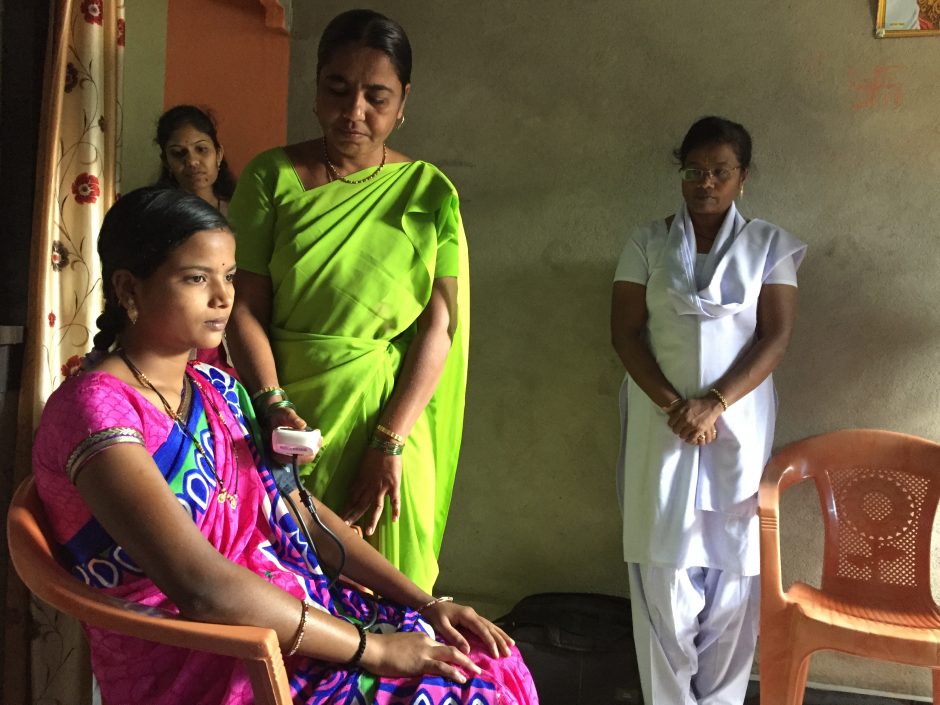
This story is about a woman with poor socioeconomic status in one of the pilot intervention clusters from CLIP India. Her occupation is a farmer and she lives with her mother-in-law, husband, and her two children, where the mother-in-law is the decision maker in the family.
In the first and second trimester of pregnancy the woman had no complaints. In her third trimester when an ANM examined her blood pressure it was found to be 146 mm-Hg systolic. She was referred to a higher care facility where she was prescribed tab methyldopa 250 mg twice a day. She was on regular treatment for a few days, but stopped because her mother-in-law stated “if you don’t have any problems then why do you take medicine, it is waste of money and may also affect your child.” The woman agreed to what her mother-in-law said as she did not have any complications.
Around 37 weeks of gestation she was examined again by a ANM and her blood pressure was found to be 170 mm. Hg systolic with proteinuria 2+. The AMN explained the severity of the situation and reccomended her to take oralmethyldopa and, have a MgSO4 injection, and to go a higher level facility for further management. Local transportation was arranged and the woman was taken to the taluka level hospital. She was accompanied by her mother-in-law. By the time the hospital examined her blood pressure it was normal, and her husband and mother-in-law upon hearing this took her back to the village without telling the hospital staff.
On the second day, the woman started getting mild headaches and swelling of the limbs. The mother-in-law took her to a nearby PHC, outside the study area, to have her blood pressure examined and it was found to be 190 mm. Hg systolic. The medical officer tried to explain over the phone the severity of hypertension in pregnancy and its adverse impacts on a mother and her baby. The mother-in-law kept arguing with the officers that her daughter-in-law was fine with a mild headache and did not need hospital admission. She was concerned that if her daughter-in-law went to the hospital there would be no one to take care of her two children.
The medical officer was unable to convince the woman so he visited her at her home. He made child care arrangements at the mother’s home and personally paid for and arranged free transportation for the women. Finally, both women agreed after five hours of convincing.
On the woman’s admission to the hospital, her blood pressure was 196/124 mm-Hg. After two days her blood pressure did not decrease and she was put on intravenous and oral Labetalol. Once her blood pressure was controlled she had a caesarean section. On the operating table the woman had a cardiac arrest. She was provided CPR and was put on a ventilator, and delivered a baby boy weighing 2.3kg. The woman was shifted to an ICU on a ventilator where her conditioned worsened. She was given 24/7 ICU care, and after much effort the woman was off the ventilator and was conscious on the 8th day.
The mother happily went back to her village with her newborn baby. The central team members visited her home on one of the community engagement days and asked to her share her experience with other pregnant women. She whole heartedly agreed to participate in the community engagement activity and shared her experience about how lucky she was to survive. She said this should be taken as a lesson to those who have high blood pressure during pregnancy to regularly take medicine and follow doctor’s instructions strictly. Now she motivates the women in her village for birth preparedness and regular ANC follow-up.
Submitted by Dr Umesh S Charantimath
Project Co-ordinator, CLIP India.